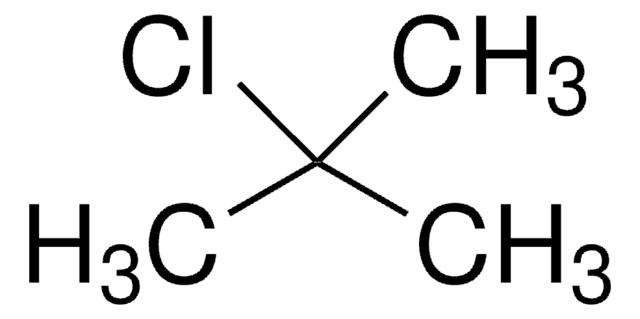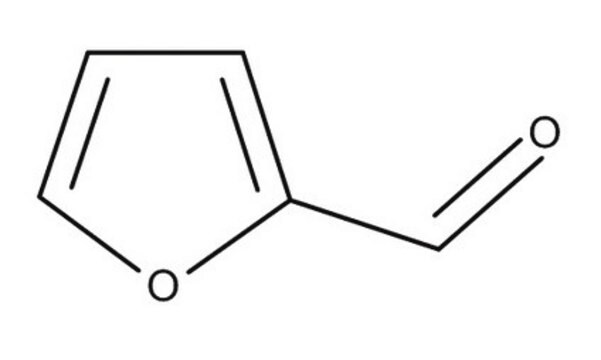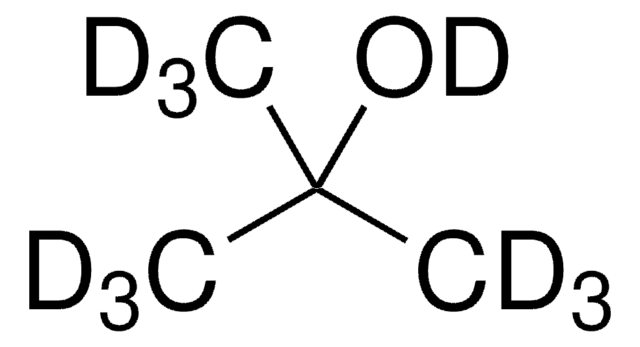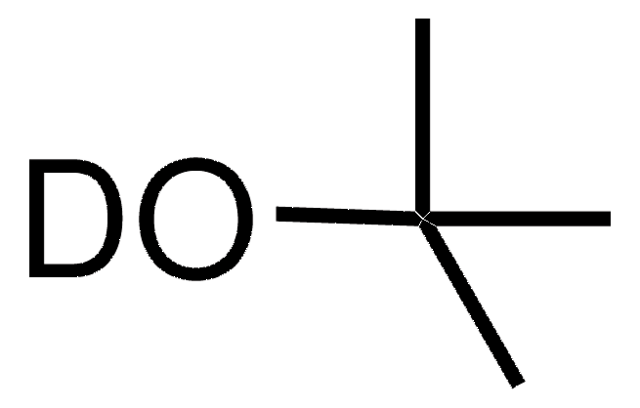Wichtige Dokumente
308250
tert-Butanol
suitable for HPLC, ≥99.5%
Synonym(e):
2-Methyl-2-propanol, tert-Butylalkohol, Trimethylcarbinol
About This Item
Empfohlene Produkte
Qualität
HPLC grade
Dampfdichte
2.5 (vs air)
Dampfdruck
31 mmHg ( 20 °C)
44 mmHg ( 26 °C)
Assay
≥99.5%
Form
liquid
Selbstzündungstemp.
896 °F
Expl.-Gr.
8 %
Methode(n)
HPLC: suitable
Verunreinigungen
<0.050% water
Abdampfrückstand
<0.0005%
Brechungsindex
n20/D 1.387 (lit.)
pH-Wert
7 (20 °C)
bp
83 °C (lit.)
mp (Schmelzpunkt)
23-26 °C (lit.)
Dichte
0.775 g/mL at 25 °C (lit.)
λ
H2O reference
UV-Absorption
λ: 215 nm Amax: 1.00
λ: 230 nm Amax: 0.50
λ: 250 nm Amax: 0.20
λ: 300-350 nm Amax: 0.01
Anwendung(en)
food and beverages
SMILES String
CC(C)(C)O
InChI
1S/C4H10O/c1-4(2,3)5/h5H,1-3H3
InChIKey
DKGAVHZHDRPRBM-UHFFFAOYSA-N
Suchen Sie nach ähnlichen Produkten? Aufrufen Leitfaden zum Produktvergleich
Allgemeine Beschreibung
Anwendung
Used in the analysis of volatile organic compounds (VOCs) in alcoholic beverages by GC coupled to Flame Ionization Detector (FID).
Verpackung
As a global leader in lab reagents, we are constantly looking for new ways to optimize the safety of our products. The newly developed 4L solvent bottle design features advanced sealing technology that eliminates leaks to make the handling of solvents safer and more convenient than ever before.
See all the new features here!
Signalwort
Danger
H-Sätze
Gefahreneinstufungen
Acute Tox. 4 Inhalation - Eye Irrit. 2 - Flam. Liq. 2 - STOT SE 3
Zielorgane
Central nervous system, Respiratory system
Lagerklassenschlüssel
3 - Flammable liquids
WGK
WGK 1
Flammpunkt (°F)
59.0 °F - closed cup
Flammpunkt (°C)
15 °C - closed cup
Hier finden Sie alle aktuellen Versionen:
Besitzen Sie dieses Produkt bereits?
In der Dokumentenbibliothek finden Sie die Dokumentation zu den Produkten, die Sie kürzlich erworben haben.
Kunden haben sich ebenfalls angesehen
Protokolle
-Butanol; 2-Methyl-2-butanol; 2-Methyl-1-butanol; 3-Pentanol; 1-Butanol; 2-Methyl-1-propanol; 2-Pentanol, 98%; 3-Methyl-1-butanol; 1-Propanol
Unser Team von Wissenschaftlern verfügt über Erfahrung in allen Forschungsbereichen einschließlich Life Science, Materialwissenschaften, chemischer Synthese, Chromatographie, Analytik und vielen mehr..
Setzen Sie sich mit dem technischen Dienst in Verbindung.








